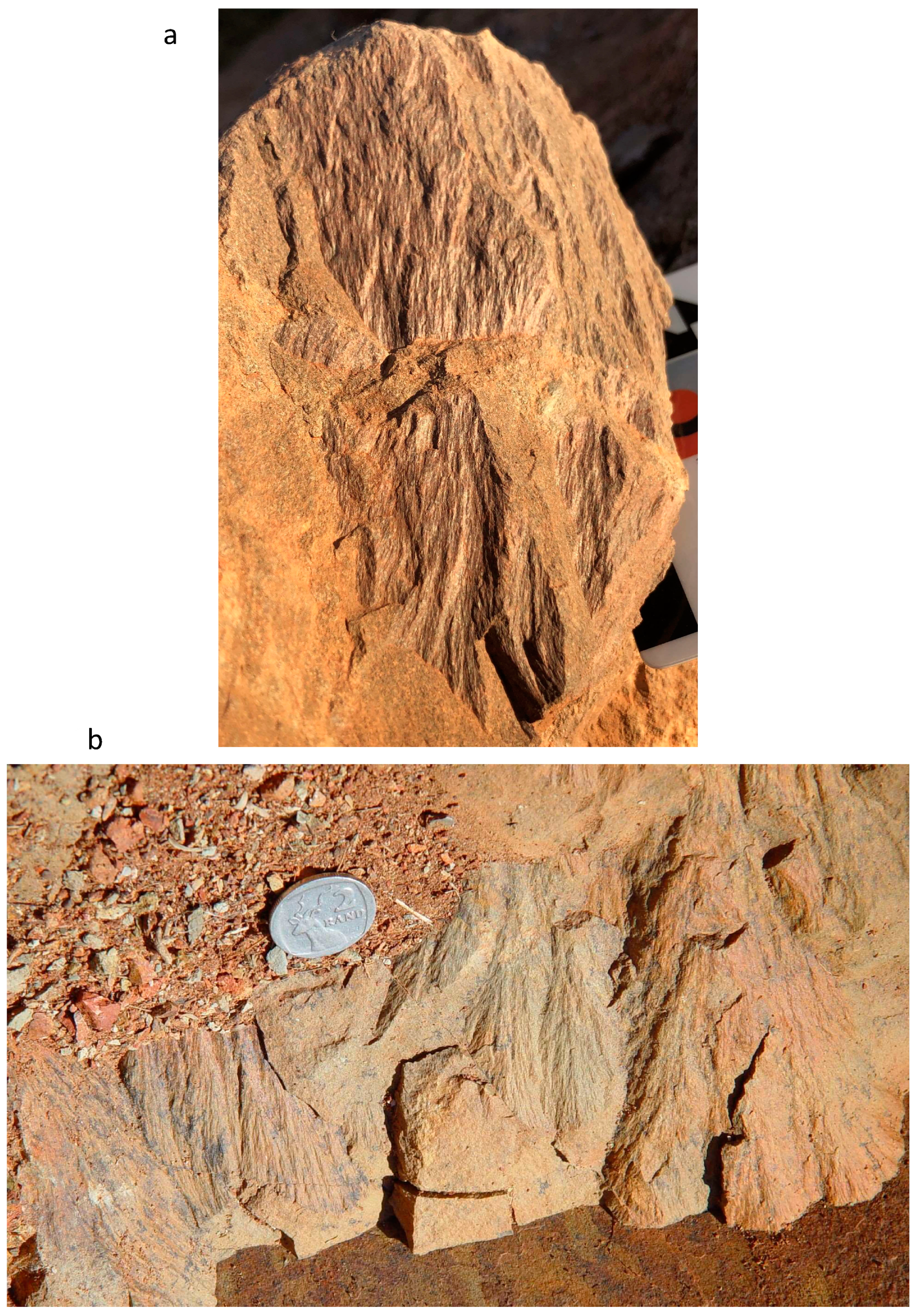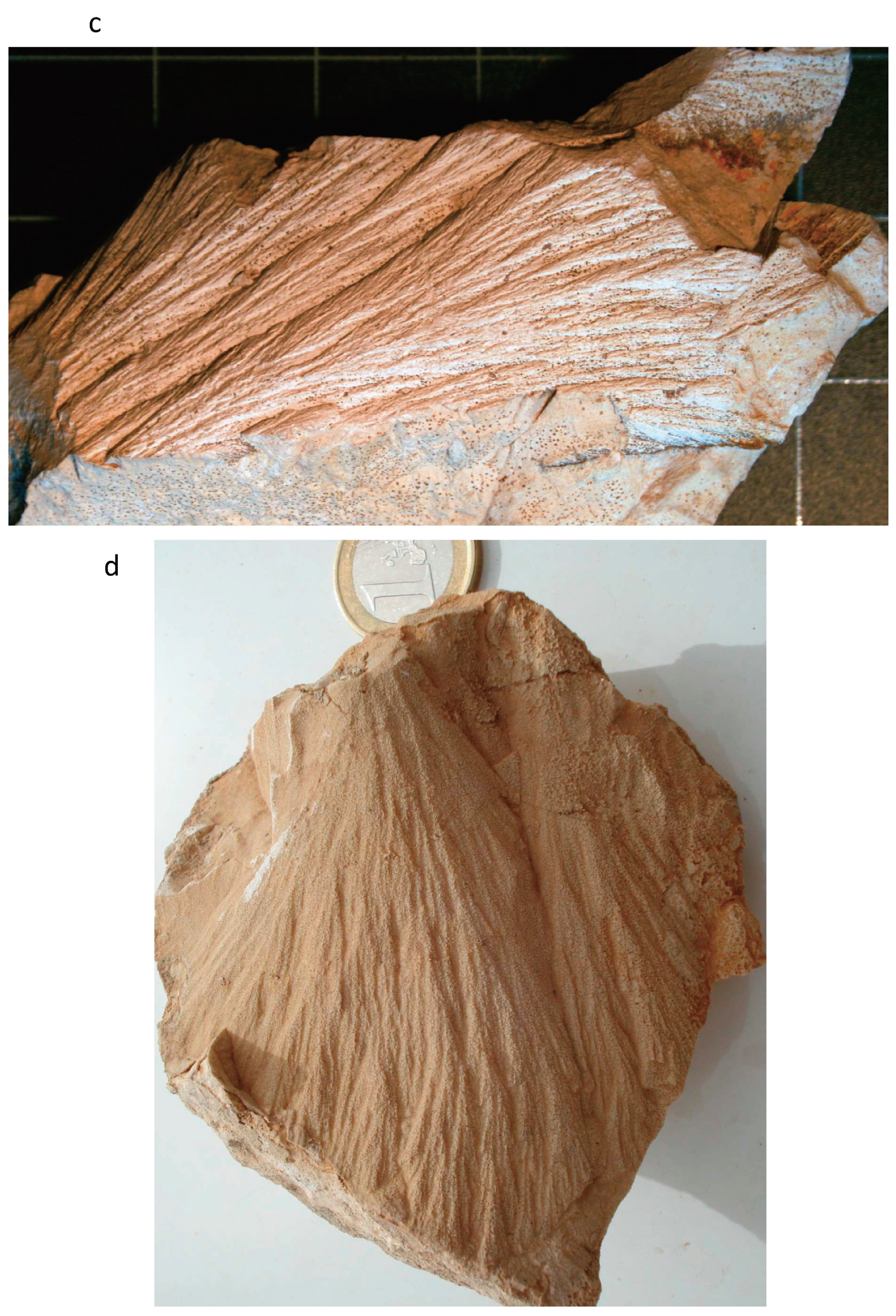Comment on Nasir et al. The Mahout Structure in the Central Desert of Oman: A Possible Simple Impact Crater. Geosciences 2023, 13, 363
Abstract
1. Introduction
2. Field Observations
3. Shatter Cones
4. Shock Metamorphic Effects
- -
- The allegation of PDFs in plagioclase remains entirely unsupported and seems to constitute an error of the authors, who probably meant to refer to PFs. Their observation of alternate twin deformation should have been illustrated/described in detail.
- -
- Their figure 8 allegedly shows “yellowish brown globular clasts of glasses” (p. 9) in both plane- and cross-polarized light images. The reader remains surprised and disturbed by the fact that in cross-polarized light, these “glass” clasts do not show isotropism. In figure 12, black glass is alleged to occur in black groundmass. The illustrations do not support this claim of presence of glass. And again, in figure 14, a brown glass phase is alleged that does not show optical extinction in cross-polarized light. Thus, whether any of the alleged polymict breccias are glass-bearing remains highly dubious.
- -
- Planar fractures (PFs), when occurring in multiple sets of (sub)planar, parallel features in quartz, are widely considered an impact-diagnostic phenomenon. According to Nasir et al. [1], PFs are present in Mahout quartz. In figure 9a, PFs should be visible, but they are not. The white lines used to indicate their presence and orientation are supposed to be 2–5 μm apart, but the spacing is more like 10 μm. It is not clear which phase (quartz?) is shown in figure 9b, but anyway, the alleged planar features remain obscure (either the thin section is of poor quality, or the grain is recrystallized). There is one set of subplanar features (fractures?) in quartz in figure 10a; however, they are partially divergent, as marked by the authors themselves with divergent white lines, and not parallel like planar fractures of shock origin should be. If there are PFs in quartz in figure 10b, they would be, in part, clearly divergent. Finally, in Supplementary Material (SM3) figure S2a, PFs are supposed to be shown in quartz as well. Unfortunately, the complex topography (?) of this grain does not allow to verify this. The same holds for the quartz grain in SM figure S3a.
- -
- Planar fractures in plagioclase are supposedly shown in figure 9a, where the white-line annotations again indicate divergence; the alleged fractures are invisible anyway. In figure 10b, divergent white lines mark “something” indeterminate in plagioclase, and in the lower part of this crystal, possible broad fluid inclusion trails may occur. Their figure 11a,b may show some planar features in this mineral, but whether they are fractures, cleavage, or something else is not clear. The white lines drawn onto figure 11b again seem to indicate divergence in orientation. In figure 15a,b, planar features remain invisible, and many white-line markings are divergent. In figure S1a of the SM, a set of subparallel but frequently curved features is shown. Whether this image shows two sets of planar fractures remains to be proven (by the authors). The alleged PFs in figure S1b are marked with white lines that are strongly divergent; PFs are, in this microphotograph, essentially invisible. SM3 figure S2a does not show planar fractures but rather plagioclase twinning, as does figure S2b. Whether there is partial isotropization as claimed cannot be judged on the basis of this image. If the authors want to prove this, further analytical work is required. In figure SM3 S3b, undulous extinction and PFs are supposed to be shown. The former is not a diagnostic shock effect, and the latter are invisible.
- -
- Planar fractures in calcite are alleged for SM3 images S4a,b. What the authors are showing are undoubtedly cleavage traces, likely parallel to twin planes. Even if there were planar fractures in this calcite grain, PFs in this mineral with excellent cleavage are not considered bona fide shock deformation.
- -
- Feather features (FFs) in quartz and plagioclase are mentioned in conjunction with a number of illustrations but remain elusive. It must be pointed out that FFs have never been described from feldspar minerals, and as such, are not recognized as shock (impact) evidence. Their figures 9a,b, 10a, 11a, and 13b supposedly show FFs, but they are not visible. The quality/resolution of the photomicrographs is insufficient. Further evidence for the existence of FFs in these samples is not provided either.
- -
- Coesite aggregates are alleged to occur in a breccia sample from Mahout. The authors claimed to have confirmed this using X-ray diffraction and provide a diffractogram that mainly displays peaks for quartz and minor phyllosilicate. Whether there are peaks for coesite must be demonstrated much better. Whether there are coesite aggregates in this sample must be verified by state-of-the-art analysis, such as Raman spectroscopy or transmission electron microscopy. As it stands now, this cited evidence must be considered with doubt.
5. Geochemistry
6. Geophysics
7. Discussion and Conclusions
- -
- Allegation of stratigraphic inversion at the top of the structure’s rim: This must be fully demonstrated by further structural geological and stratigraphic analysis.
- -
- Presence of ejecta inside and outside of the crater: An ejecta blanket is inferred but not demonstrated (such as a mapped distribution of fragments under the consideration of the particular topography at the site and the desert environment, orientation of rock fragments, definition and orientation of ejecta rays, and in any case, melt-bearing lithologies (see below). As mentioned above, the possible difference between proximal and distal debris on the surface around the alleged crater structure must be evaluated.
- -
- Allegation of four samples with possible shatter cones: The illustrations provided do not allow the confirmation of this claim. Thus, further work on these possibly crucial samples is required. This should also involve a petrographic analysis of the samples’ interiors, as planar fractures and planar deformation features (PDFs) have been occasionally observed inside samples with shatter cone surfaces. A detailed characterization of where these critical samples were observed and of the samples’ morphologies is mandatory. How do these samples compare against bona fide, impact-generated shatter cones (compare Figure 1)?
- -
- Alleged presence of “coesite aggregates”: The X-ray diffractogram provided does not allow the confirmation of this claim. Further state-of-the-art analysis using SEM and especially Raman spectroscopy, perhaps even TEM, are required to confirm the presence of this high-pressure polymorph in a sample from Mahout.
Funding
Acknowledgments
Conflicts of Interest
References
- Nasir, S.; Economou, N.; Al Hooti, K.; Al Hosni, T.; Spratley, S.; Spratley, B. The Mahout structure in the central desert of Oman: A possible simple impact crater. Geosciences 2023, 13, 363. [Google Scholar] [CrossRef]
- French, B.M.; Koeberl, C. The convincing identification of terrestrial meteorite impact structures: What works, what doesn’t, and why. Earth-Sci. Rev. 2010, 98, 123–170. [Google Scholar] [CrossRef]
- Ferrière, L.; Morrow, J.R.; Amgaa, T.; Koeberl, C. Systematic study of universal-stage measurements of planar deformation features in shocked quartz: Implications for statistical significance and representation of results. Meteorit. Planet. Sci. 2009, 44, 925–940. [Google Scholar] [CrossRef]
- Reimold, W.U.; Koeberl, C. Impact structures in Africa: A review. J. Afr. Earth Sci. 2014, 93, 57–175. [Google Scholar] [CrossRef]
- Reimold, W.U.; Ferrière, L.; Deutsch, A.; Koeberl, C. Impact controversies: Impact recognition criteria and related issues. Meteorit. Planet. Sci. 2014, 49, 723–731. [Google Scholar] [CrossRef]
- Baratoux, D.; Reimold, W.U. The current state of knowledge about shatter cones: Introduction to the special issue. Meteorit. Planet. Sci. 2016, 51, 1389–1434. [Google Scholar] [CrossRef]
- Koeberl, C. The geochemistry and cosmochemistry of impacts. In Treatise on Geochemistry, 2nd ed.; Holland, H.D., Turekian, K.K., Eds.; Elsevier: Oxford, UK, 2014; Volume 2, pp. 73–118. [Google Scholar] [CrossRef]
- Kenkmann, T. The terrestrial impact crater record: A statistical analysis of morphologies, structures, ages, lithologies, and more. Meteorit. Planet. Sci. 2021, 56, 1024–1070. [Google Scholar] [CrossRef]
- Nicolaysen, L.O.; Reimold, W.U. Vredefort shatter cones revisited. J. Geophys. Res. 1999, 104, 4911–4930. [Google Scholar] [CrossRef]
- Osinski, G.R.; Ferrière, L. Shatter cones: (Mis)understood? Sci. Adv. 2016, 2, e1600616. [Google Scholar] [CrossRef] [PubMed]
- Stöffler, D.; Hamann, C.; Metzler, K. Shock metamorphism of planetary silicate rocks and sediments: Proposal for an updated classification system. Meteorit. Planet. Sci. 2018, 53, 5–49. [Google Scholar] [CrossRef]
- Kowitz, A.; Güldemeister, N.; Schmitt, R.-T.; Reimold, W.U.; Wünnemann, K.; Holzwarth, A. Revision and recalibration of existing shock classifications for quartzose rocks using low-shock pressure (2.5–20 GPa) recovery experiments and mesoscale numerical modeling. Meteorit. Planet. Sci. 2016, 51, 1741–1761. [Google Scholar] [CrossRef]
- Wittmann, A.; Kenkmann, T.; Schmitt, R.T.; Stöffler, D. Shock metamorphosed zircon in terrestrial impact craters. Meteorit. Planet. Sci. 2006, 41, 433–454. [Google Scholar] [CrossRef]
- Timms, N.E.; Erickson, T.M.; Pearce, M.A.; Cavosie, A.J.; Schmieder, M.; Tohver, E.; Reddy, S.M.; Zanetti, M.R.; Nemchin, A.A.; Wittmann, A. A pressure-temperature phase diagram for zircon at extreme conditions. Earth Sci. Rev. 2017, 165, 185–202. [Google Scholar] [CrossRef]


Disclaimer/Publisher’s Note: The statements, opinions and data contained in all publications are solely those of the individual author(s) and contributor(s) and not of MDPI and/or the editor(s). MDPI and/or the editor(s) disclaim responsibility for any injury to people or property resulting from any ideas, methods, instructions or products referred to in the content. |
© 2024 by the author. Licensee MDPI, Basel, Switzerland. This article is an open access article distributed under the terms and conditions of the Creative Commons Attribution (CC BY) license (https://creativecommons.org/licenses/by/4.0/).
Share and Cite
Reimold, W.U. Comment on Nasir et al. The Mahout Structure in the Central Desert of Oman: A Possible Simple Impact Crater. Geosciences 2023, 13, 363. Geosciences 2024, 14, 105. https://doi.org/10.3390/geosciences14040105
Reimold WU. Comment on Nasir et al. The Mahout Structure in the Central Desert of Oman: A Possible Simple Impact Crater. Geosciences 2023, 13, 363. Geosciences. 2024; 14(4):105. https://doi.org/10.3390/geosciences14040105
Chicago/Turabian StyleReimold, Wolf Uwe. 2024. "Comment on Nasir et al. The Mahout Structure in the Central Desert of Oman: A Possible Simple Impact Crater. Geosciences 2023, 13, 363" Geosciences 14, no. 4: 105. https://doi.org/10.3390/geosciences14040105
APA StyleReimold, W. U. (2024). Comment on Nasir et al. The Mahout Structure in the Central Desert of Oman: A Possible Simple Impact Crater. Geosciences 2023, 13, 363. Geosciences, 14(4), 105. https://doi.org/10.3390/geosciences14040105






